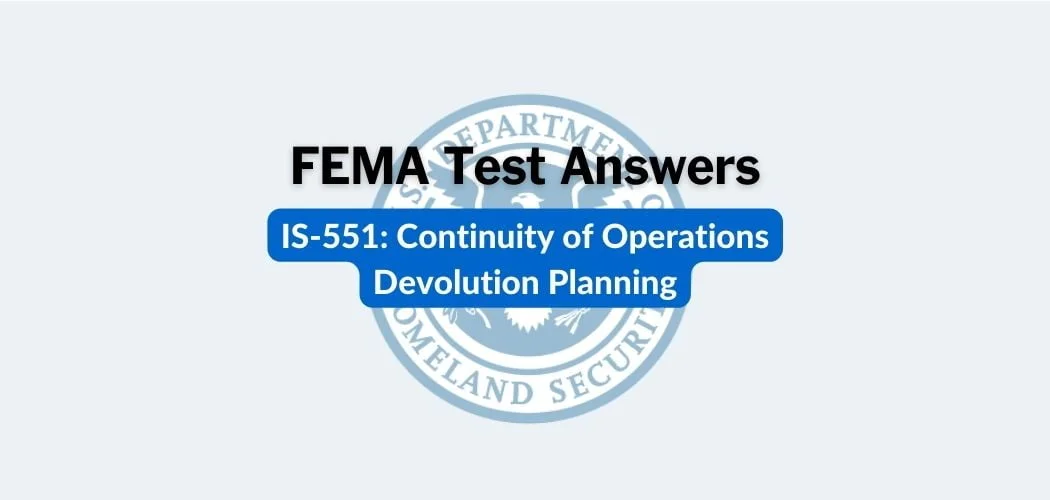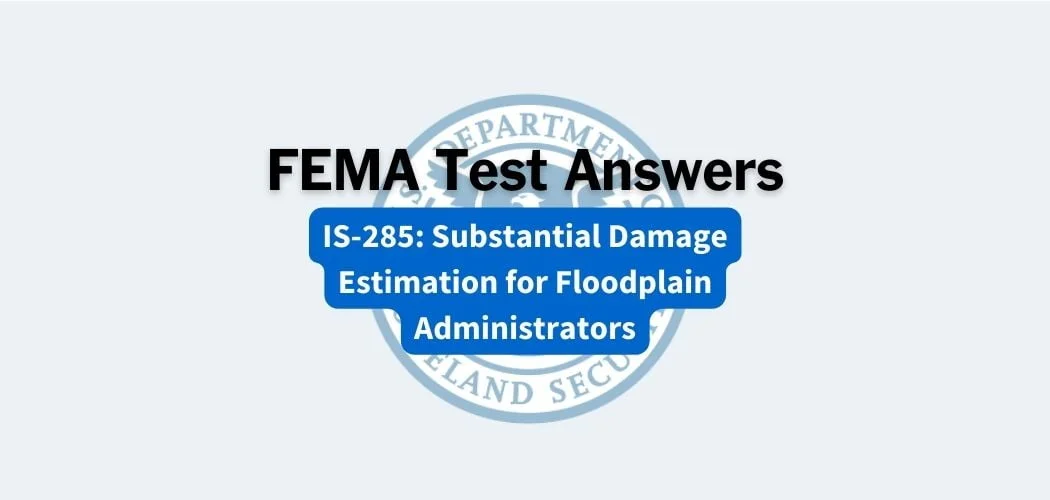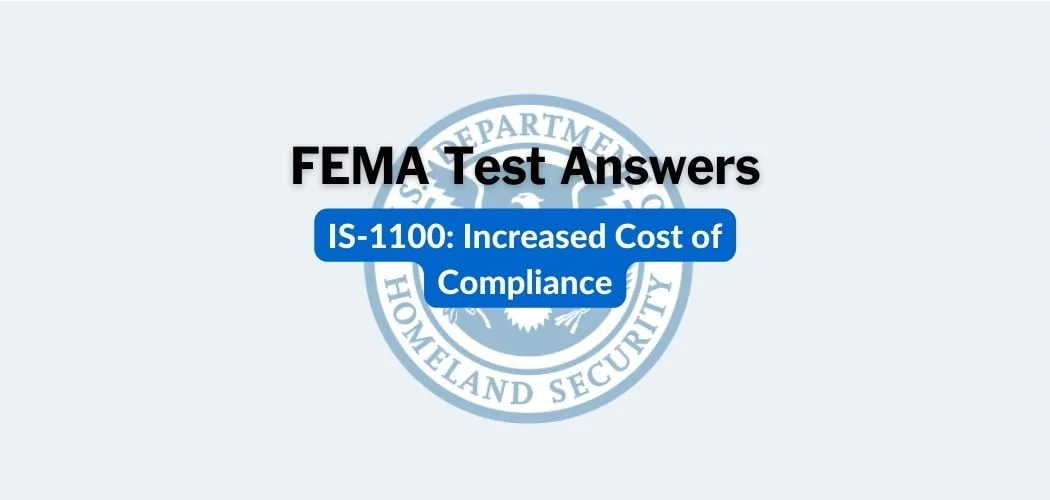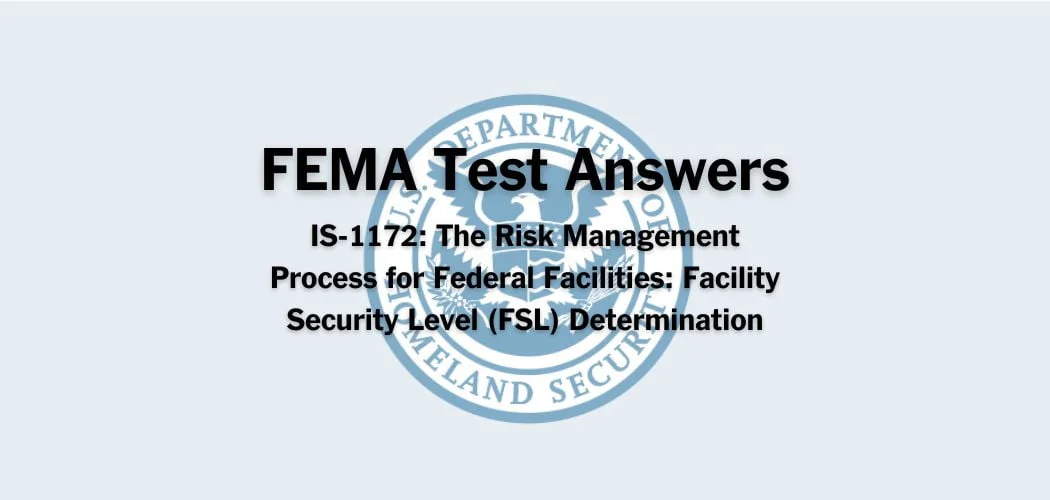Overview: The FEMA IS-394.A course was published on 10/22/2022 to address different types of hazards and describe specific measures that you can take to protect your home and place of business.
Primary audience: FEMA IS-394.A is for all small business owners, homeowners, and individual citizens for them to learn how to identify the different types of hazards and the likelihood they will affect their community.
FEMA IS-394.A test answers
Each time this test is loaded, you will receive a unique set of questions and answers. The test questions are scrambled to protect the integrity of the exam.
Question 1. An example of a structural measure to protect against damage is to:
A. Move heavy objects away from seating areas.
B. Clear flammable vegetation to create a safety zone.
C. Move important documents to the upper floor.
D. Elevate a building in a flood-prone area.✅
Question 2. Installing backflow valves is a measure used for which item below?
A. toilet bowl
B. sewer system
C. drain pipe✅
D. flood insurance
Question 3. The most common type of disaster in the United States is:
A. Flooding.✅
B. Hurricanes.
C. Wildfires.
D. Tornadoes.
Question 4. One hazard that can be predicted days in advance is a:
A. Tsunami.
B. Earthquake.
C. Hurricane.✅
D. Wildfire.
Question 5. Sources of local government information about hazards affecting your area include:
A. Building and zoning officials.
B. Planning department.
C. Floodplain manager.
D. All of the above.✅
Question 6. To protect windows from wind damage, which measure is recommended?
A. Buy or make storm shutters✅
B. Cover windows with plastic
C. Leave windows open
D. Use sliding bolts
Question 7. To prevent water from entering your home, what protective measure should you install if you have a floor drain?
A. Float plugs✅
B. Floodwall
C. Sump pump
D. Covering with wood
Question 8. Earthquakes occur most frequently:
A. In the Upper Midwest.
B. West of the Rocky Mountains.✅
C. At the New Madrid fault in Missouri.
D. East of the Rocky Mountains.
Question 9. An example of fire-resistant roofing material is:
A. Tile roofing.✅
B. Tar-sealed roofing.
C. Asphalt shingles.
D. Wood shakes.
Question 10. The most common type of wildfire is a surface fire, which generally is started by:
A. Downed power lines.
B. Hot, dry conditions.
C. Lightning.
D. People.✅
Question 11. The cripple wall can be protected in an earthquake with the following measure.
A. Brace with horizontal blocking✅
B. Install shutters
C. Install hurricane straps
D. Secure to the floor
Question 12. Hazards reviewed in detail in the course include:
A. Flooding, earthquakes, tornadoes, hurricanes, and wildfires.✅
B. Flooding, earthquakes, tornadoes, tsunamis, and wildfires.
C. Landslides, hurricanes, tornadoes, and earthquakes.
D. Landslides, earthquakes, wildfires, and hurricanes.
Question 13. The _____ should be secured with sheet metal straps and angle bracing to protect against an earthquake.
A. Chimney✅
B. Double doors
C. Wall
D. Windows
Question 14. To reduce earthquake damage in homes with a perimeter foundation, you should make sure this is securely bolted to the foundation.
A. Fuel tanks
B. The sill plate✅
C. Furniture
D. Garage doors
Question 15. A nonstructural measure to avoid earthquake damage is:
A. Fastening water heaters.✅
B. Securing chimneys with metal straps.
C. Elevating the structure.
D. Bracing cripple walls.
Question 16. To ensure a garage door is strong enough to resist hurricane-force winds, this measure would be required.
A. Reinforce with nails
B. Board up the door
C. Install horizontal bracing✅
D. Remove the door
Question 17. Which protective measure is used for propane and heating oil tanks to protect against flooding?
A. Draining
B. Moving to higher ground✅
C. Anchoring
D. Placing barriers around them
Question 18. What should you do with your washer and dryer to protect them from flooding?
A. Elevate them at least 5 feet above the floor
B. Insert a rug or wood underneath the appliance
C. Move them to another part of the basement
D. Elevate them at least 1 foot above the projected flood level✅
Question 19. What structures would be protected against wind damage by securing them with sliding bolts?
A. Windows
B. Double-entry doors✅
C. Furniture
D. Decks
Question 20. A nonstructural measure you can take before a hurricane is predicted to hit your area is:
A. Secure the foundation to the walls of your home.
B. Bring in outdoor furniture and other personal property kept outdoors.✅
C. Construct a safe room below ground level.
D. Install plywood shutters to protect windows.
Question 21. Install hurricane straps to this structure to protect your home or small business from high winds.
A. Window
B. Roof✅
C. Door
D. Floor
Question 22. To find the projected flood level for your home or place of business, you should consult:
A. Satellite photos of your community.
B. United States Geological Service (USGS) quadrangle maps of your community.
C. A flood map of your community.✅
D. Neighbors who are familiar with your community’s flooding history.
Question 23. Retrofitting measures to protect against water damage include:
A. Elevating utilities and service equipment.✅
B. Obtaining adequate flood insurance.
C. Bracing foundations.
D. Securing doors and windows.
Question 24. Structures that are especially susceptible to wind damage are:
A. Steel-frame buildings.
B. Brick structures.
C. Buildings with roofs secured with hurricane straps.
D. Manufactured homes.✅
Question 25. A measure that can be used to create a safety zone around a home or business to protect against wildfire is:
A. Do not connect wooden fencing directly to your home.✅
B. Cover windows with heavy drapes.
C. Move outdoor furniture indoors.
D. Turn off gas supply lines.



